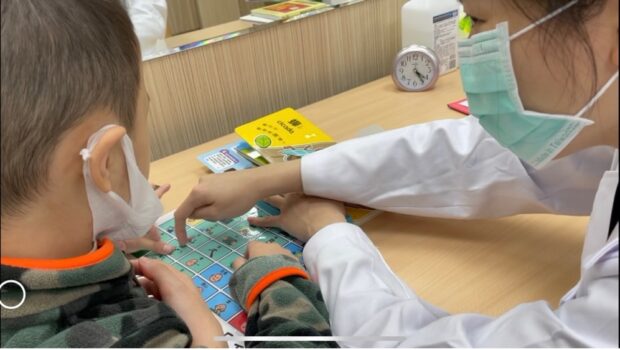AAC Intervention For Multicultural Families – Similarities and Differences Across Cultures
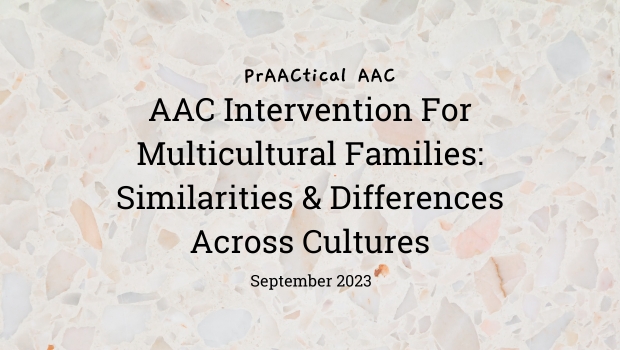
Across the world, AAC teams are looking for ways to strengthen their support of multilingual individuals with complex communication needs. In this article, guest authors Hsiao-Ting Su and Wen-Hsin Ku, who are both bilingual Mandarin-English SLPs, share their thoughts.
AAC Intervention for Multicultural Families – Similarities and Differences Across Cultures
Though there are limited AAC resources in minority languages at this time, SLPs should make every effort to meet the needs of multicultural families. It is crucial for SLPs to keep cultural differences in mind when working with multicultural families. As two bilingual English-Mandarin-speaking SLPs who have worked with both families in the U.S. and Taiwan, we have first-hand experience navigating similarities and differences across cultures. Here, we describe some of the similarities and differences we have encountered most frequently.
- Similarities:
- Families worry that AAC will hinder verbal communication development
- Families need reassurance that it is okay for children to explore their AAC device
- Differences:
- Many families from Taiwan need additional information about the benefits of play-based, child-led approaches to intervention
- Multilingual families living in the U.S. benefit from SLPs’ advocacy for minority language preservation
Similarities
Families worry that AAC will hinder verbal communication development.
Many parents in both Taiwan and the U.S. worry that using AAC might hinder their child’s further speech development. Concerned that AAC will interfere with their child’s speech development, many parents choose not to use AAC and seek out therapists to work only on spoken language. For example, one family that I (Hsiao-Ting) worked with once asked me, “After using AAC, will our child become lazy and stop speaking, only relying on the device to communicate?” To address the concern, I reassured the family based on research and my own experience. I explained that using AAC does not impede speech development; rather, it serves as a valuable tool that supports and enhances communication (Romski & Sevcik, 2005; Schlosser & Wendt, 2008). I made sure to highlight and celebrate every small achievement in communication in the child, such as gestures, facial expressions, and body movements, letting the family know that all forms of communication are valid and acknowledged. By acknowledging these various forms of communication, the family began to understand that their child was already expressing himself, and using symbols through AAC could further enhance his communication. It was important to continuously provide reassurance and guidance, empowering the family to better support their child’s overall communication development.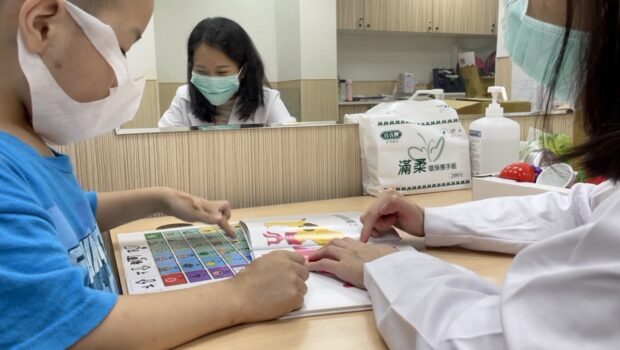
Families need reassurance that it is okay for children to explore their AAC devices.
Another cross-cultural barrier is that many parents have difficulties accepting their child making mistakes, including pressing the wrong buttons or exploring buttons on the AAC device. When the children fail to select the correct symbol or button, they may be unfairly labeled as incompetent in using AAC, not comprehending visual representations, or even as non-compliant troublemakers who only play with buttons randomly. For instance, I (Hsiao-Ting) once worked with a mom who would hold her son’s hand to press each button on the AAC device and would take away the device if he randomly pressed buttons. She said, “He doesn’t understand. He’s just randomly pressing buttons.” I explained to her that it is okay and in fact encouraged for children to explore and experiment with their AAC device (Zangari, 2015), just as children who use spoken language engage in playful vocal experiments. Additionally, I emphasized that we cannot be certain if the child was pressing buttons randomly or actually attempting to communicate something. Responding to his actions as if he were genuinely communicating would help him associate the symbol he pressed with the message he intended to convey. After continually reassuring and consulting with the mom, she started modeling on the AAC device without expecting her son to use it immediately and allowing him to explore it freely while also seeing his exploration as communication. After a while, the mom and I were both thrilled to see her son begin pointing to symbols to communicate as expected. By avoiding too much direction and correction and instead allowing children to experiment and practice, they can develop self-confidence in their ability to communicate and learn.
Differences
Many families from Taiwan need additional information about the benefits of play-based, child-led approaches to intervention.
Many of the families we have encountered as SLPs report less familiarity with unstructured therapy intervention approaches (e.g., routine-based, play-based, child-led approaches). This is likely due to cultural differences, including parents’ beliefs that:
- Children should respect their elders and obey all orders given by an elder/teacher.
- Children should remain focused and learn while seated at a desk.
- Children learn more in highly structured activities.
- Unstructured playtime is a “break” or “reward” after learning instead of an integral part of learning.
As bilingual SLPs working with families in or from Taiwan, we often have to provide a strong rationale for our choice of less structured approaches, especially when previous SLPs used more structured, adult-led therapy approaches. For example, a Taiwanese family I (Wen-Hsin) once worked with benefited significantly from family education at the beginning of our therapeutic relationship. During our first few in-home therapy sessions, my client’s grandmother insisted that my client must clean up all the toys in the living room in order for our “class to begin.” I decided to invest a significant amount of time discussing the importance and numerous benefits of utilizing a child-led, play-based approach for AAC intervention (e.g., creating opportunities for modeling and language learning in natural communication contexts that are meaningful to the child, increasing the child’s intrinsic motivation, facilitating carryover across communication contexts, decreasing prompt dependency, etc.). Although this family initially required more time and support to understand the importance of using a child-led, play-based approach, they became convinced as they gradually noticed their child begin to spontaneously use his AAC device to communicate his wants, needs, and ideas much more frequently. As a result, they witnessed less frustration as well as significantly improved mood and intrinsic motivation as my client always looked forward to therapy, which unfortunately was not always the case with previous therapists who utilized more structured, compliance-based, adult-led approaches.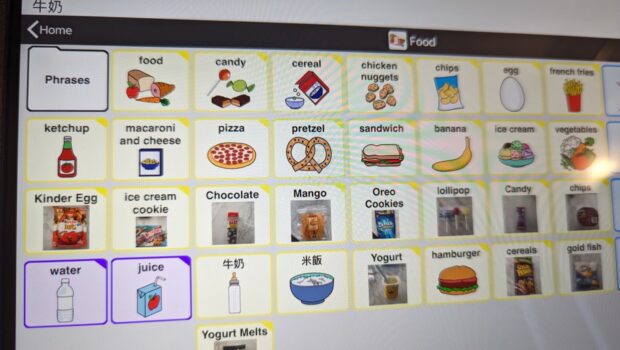
Multilingual families living in the U.S. benefit from SLPs’ advocacy for minority language preservation.
When providing AAC intervention to children from multicultural families, another cross-cultural difference we have encountered is the challenge of minority language preservation. In the U.S., it is not uncommon for bilingual and multilingual families to receive advice from well-meaning but misguided medical professionals (e.g., doctors, SLPs, etc.) that they should “only use English” at home when their child has a developmental disability, complex communication needs, or a language delay. This is clearly outdated advice, as research (Yu, 2018) has shown, for example, that bilingual and monolingual autistic children have comparable developmental outcomes. Yu (2018, p. 1) also found that “home language development is beneficial for English acquisition.” When working with bilingual parents who have followed this outdated advice from medical professionals, we have found that facilitating minority language preservation is a delicate, ongoing conversation. As therapists, our personal preference is to provide ample information on the benefits and importance of home language development and bilingualism to help parents make a more informed decision. However, we eventually respect caregivers’ decisions regardless of whether they choose to focus on English or preserve their home language in a bilingual approach. For example, I (Wen-Hsin) once worked with a family in which both parents were native Toisanese (a Chinese dialect) speakers but chose to only use primarily English with their 3-year-old non-speaking autistic son. Throughout our therapeutic relationship, I repeatedly explained the benefits of bilingualism and home language development and offered numerous suggestions on how parents could increase my client’s exposure to Toisanese on his AAC device (which was difficult to begin with since there is currently no AAC system programmed for Toisanese-speaking users). Ultimately, my client’s parents decided to start small by changing the speech output of certain food and family member icons from English to Toisanese – parents chose to program the words that they primarily use in Toisanese (e.g., milk, noodles, mom, dad, older sister). This provided me an opportunity to show parents how to customize the client’s AAC system (Proloquo2Go) by using previously recorded Toisanese words as the speech output for certain icons (e.g., “milk” became “nainai”). After this client’s mother replaced the synthesized English speech output with the Toisanese recordings, his parents and I witnessed the client quickly understanding the meanings of these icons and spontaneously using them to communicate.
Limited AAC Resources In Minority Languages at This Time
One significant difference between Taiwan and the U.S. is the availability of resources and information, which has a notable impact on AAC intervention. There are limited resources and information about AAC in Chinese, and parents of children who need AAC have difficulty finding an SLP who knows how to teach AAC in Taiwan. However, there have been some positive developments in recent years. For example, several Chinese AAC resources have become available, such as the Mandarin AAC Facebook group (https://www.facebook.com/groups/291665680045560), @aacaactionnow AAC 今天就開始 accounts on Facebook and Instagram, the AAC 跨越鴻溝溝通平台 website (https://aac.diyi.org.tw/), and newly established AAC SLP and parent support groups on messaging platforms like Line. With the parent support group, parents who are still uncertain about using AAC with their children have a way to see or connect with other families or children using AAC. These parents may no longer feel isolated as they get to know others using AAC as a communication tool as well. With the SLP support group, SLPs have a platform to share information and discuss their difficulties using AAC. This exchange of knowledge and experiences can lead to better strategies and practices for AAC intervention in Chinese.
Conclusion
Research has shown us the significance of parent education (Berenguer et al., 2022), as family involvement is an integral part of AAC intervention that leads to increased carryover at home, reduced risk of AAC device abandonment, and improved overall communication success for our clients and students. When working with multicultural families, in addition to introducing AAC strategies such as: modeling without expectations, introducing core words, and attributing meaning to all forms of communication, SLPs must also consider cross-cultural differences that may affect a family’s perspective on AAC intervention and how we can best support our clients and families while respecting each family’s unique cultural values and differences.
References
Berenguer, C., Martínez, E. R., De Stasio, S., & Baixauli, I. (2022). Parents’ perceptions and experiences with their children’s use of augmentative/alternative communication: A systematic review and qualitative meta-synthesis. International Journal of Environmental Research and Public Health, 19(13), 8091. https://doi.org/10.3390/ijerph19138091
Romski, M., & Sevcik, R. A. (2005). Augmentative communication and early intervention: Myths and realities. Infants & Young Children, 18(3), 174–185. https://doi.org/10.1097/00001163-200507000-00002
Schlosser, R. W., & Wendt, O. (2008). Effects of augmentative and alternative communication intervention on speech production in children with autism: A systematic review. American Journal of Speech-Language Pathology, 17(3), 212–230. https://doi.org/10.1044/1058-0360(2008/021)
Yu, B. (2018). Bilingualism and autism: A summary of current research and implications for augmentative and alternative communication practitioners. Perspectives of the ASHA Special Interest Groups, 3(12), 146–153. https://doi.org/10.1044/persp3.SIG12.146
Zangari, C. (2015, January 29) Stimming or learning? considerations for kids who repeat themselves with AAC. PrAACtical AAC. https://praacticalaac.org/praactical/stimming-or-learning-considerations-for-kids-who-repeat-themselves-with-aac/
About the Guest Authors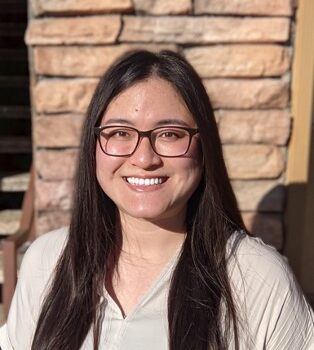
Wen-Hsin Ku, MA, CCC-SLP (she/her): Wen-Hsin is a bilingual Mandarin-English speaking pediatric Speech-Language Pathologist specializing in early intervention (0-3 population), AAC, and working with neurodivergent clients with complex communication needs. She is currently serving pediatric clients through her private practice based in San Diego, CA. Wen-Hsin is passionate about promoting awareness in AAC intervention and neurodiversity-affirming care in the Mandarin-speaking community.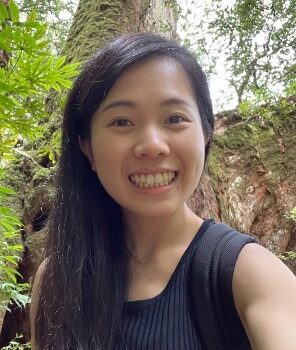
Hsiao-Ting Su, MA, CCC-SLP (she/her): Hsiao-Ting is currently a doctoral student in Speech & Hearing Sciences at the University of North Carolina-Chapel Hill where she works at the Center for Literacy Disability Studies as a research assistant. She is a bilingual Mandarin-English SLP and has worked in Taiwan and the United States. Hsiao-Ting’s research interests include AAC and literacy instruction for individuals with complex communication needs. She is also dedicated to promoting AAC knowledge and practice in the Mandarin-speaking community.
Filed under: Featured Posts
This post was written by Carole Zangari
